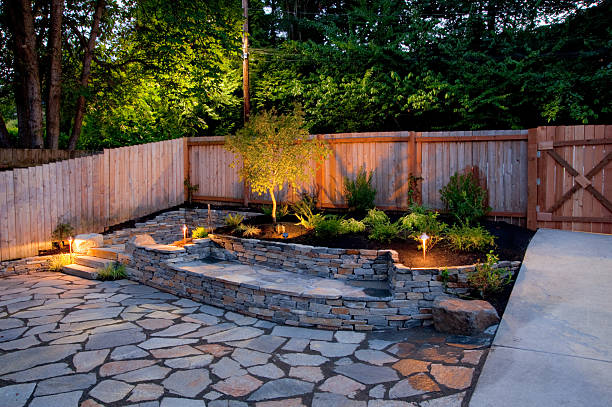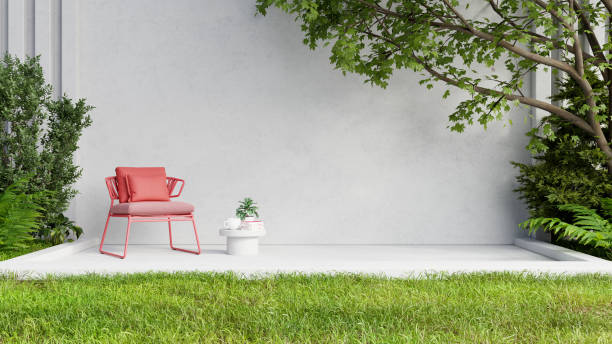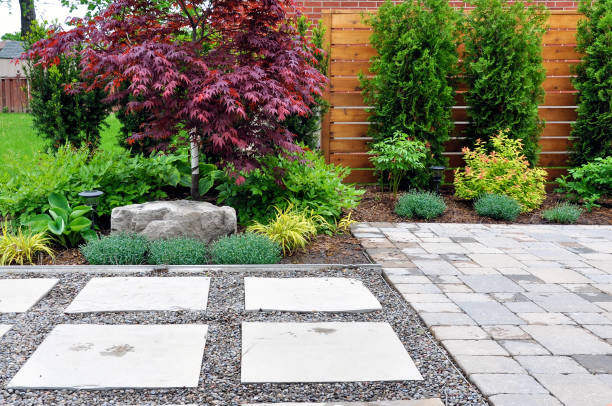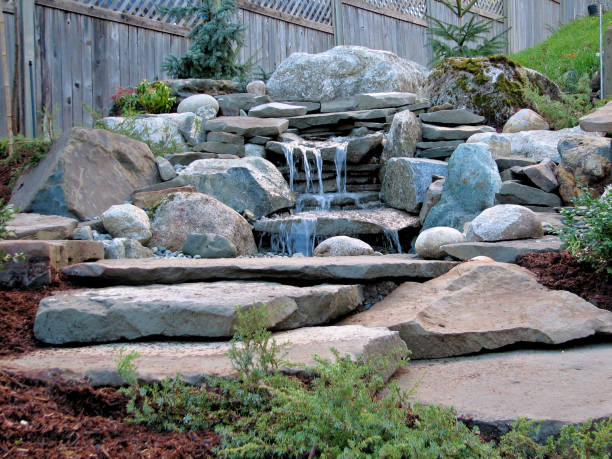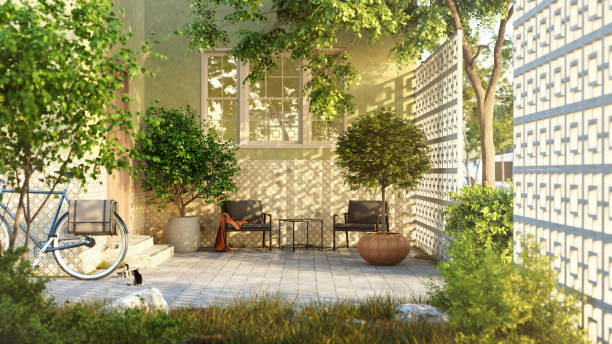
When discussing property maintenance and outdoor aesthetics, people often use the terms “lawn care” and “landscaping” interchangeably. However, these two practices serve distinct purposes, with each playing a unique role in achieving the overall beauty and functionality of outdoor spaces. Understanding the difference between lawn care and landscaping can help homeowners make informed decisions about their property’s needs.
What Is Lawn Care?
- Mowing: Regular trimming to ensure an even height for grass.
- Fertilization: Applying nutrients that promote healthy growth.
- Weed Control: Preventing or removing invasive plants that could harm grass health.
- Pest Control: Managing pests such as grubs or insects that may damage lawns.
- Watering/Irrigation Maintenance: Ensuring lawns receive adequate hydration without overwatering.
Lawn care is generally considered routine maintenance. It does not significantly alter the shape, layout, or aesthetic structure of your yard but instead works to sustain what’s already there.
What Is Landscaping?
- Planting flowers, shrubs, trees
- Installing garden beds
- Mulching
- Seasonal planting changes
- Building patios or walkways
- Constructing retaining walls
- Adding water features like fountains or ponds
- Lighting installations
Landscaping projects often require detailed planning and design to transform outdoor areas into cohesive spaces tailored to a homeowner’s preferences.
| Aspect | Lawn Care | Landscaping |
| Focus | Grass health & appearance | Outdoor space design & improvement |
| Key Activities | Mowing, fertilizing | Planting trees/shrubs; hardscape installation |
| Frequency | Routine | One-time projects or periodic updates |
| Impact | Preserves existing beauty | Enhances overall aesthetics & functionality |
Why Knowing The Difference Matters
Homeowners often face decisions about where to invest their time and money when it comes to curb appeal or functionality upgrades for their property. Knowing whether you need lawn care services (to maintain your yard) or landscaping (to elevate its design) ensures you allocate resources effectively.
For instance: – If your grass is patchy or brown but the rest of your yard looks fine, focusing on lawn care is most appropriate. – If you want to transform an uninspired backyard into an entertainment area with seating zones and flower beds, landscaping is necessary.
Both services can complement one another when done well—properly maintained lawns serve as a foundation for stunning landscapes while thoughtful landscaping enhances a healthy yard’s visual appeal. Understanding these distinctions allows individuals to address specific needs while achieving long-term goals for their properties.
Choosing Between DIY and Professional Boston, MA Landscape Solutions: What Works Best for You
When it comes to enhancing your outdoor space, one of the pivotal decisions homeowners face is choosing between a do-it-yourself (DIY) approach or hiring professional landscapers. Each option has its distinct advantages and drawbacks, depending on factors such as your budget, time, skills, and project complexity. Let’s explore both approaches to help you determine which one suits your needs best.
The Pros and Cons of DIY Landscape Design in Boston, MA
Taking the DIY route can be highly rewarding for those who enjoy hands-on projects. However, it’s essential to weigh the benefits against potential challenges.
Pros of DIY Landscaping:
– Cost-Effective: Eliminates labor costs, which can significantly reduce expenses.
– Creative Control: You have full authority over design decisions and timelines.
– Personal Satisfaction: Completing a project yourself can be highly fulfilling and meaningful.
Cons of DIY Landscaping:
– Time Intensive: Larger projects can take considerable time to plan and execute.
– Skill Limitations: Lack of expertise may lead to errors or suboptimal results.
– Equipment Costs: Renting or purchasing specialized tools may offset savings.
Best for: Small-scale projects like planting flower beds, creating container gardens, or building simple pathways.
Finding the Right Landscaper in Boston, MA: Pros and Cons
For more complex projects or those with specific requirements, hiring professionals might be a better choice.
Pros of Professional Landscaping:
– Expertise and Experience: Professionals bring industry knowledge to ensure high-quality results.
– Access to Resources: Landscapers often have access to specialized equipment and high-quality materials at lower costs.
– Time-Saving: They handle everything from planning to execution, freeing up your schedule.
Cons of Professional Landscaping:
– Higher Upfront Cost: Labor charges and materials may increase overall cost.
– Limited Flexibility During Execution: Depending on the contract, changes during the project could result in additional costs.
Best for: Large-scale transformations like designing patios, installing irrigation systems, building retaining walls, or creating sustainable landscapes.
Key Considerations When Choosing Between DIY vs Landscaping Companies in Boston, MA
| Question | DIY Approach | Professional Approach |
| What is the size/complexity? | Suitable for small/simple projects | Ideal for larger/more intricate designs |
| How much time do you have? | Requires significant personal investment | Saves you time with outsourced expertise |
| What is your budget? | Lower initial cost; may require trade-offs | May cost more but offers professional results |
| Do you need technical know-how? | May involve learning new skills | Professionals provide extensive knowledge |
Expert Tips for Lawn Care Boston, MA Homeowners
- Design flower beds or plant seasonal blooms yourself.
- Hire professionals for tasks like tree removal or installing hardscaping features.
- Use professional consultations for guidance while retaining control over execution.
Carefully evaluating your resources and objectives will ensure that whether you choose a DIY path or hire professionals (or mix both), you’ll achieve an outdoor space that enhances both aesthetics and functionality efficiently.
Exploring the Benefits of Landscaping Boston, MA Services
Landscaping encompasses a wide range of services, all aimed at enhancing the aesthetic appeal, functionality, and overall health of outdoor spaces. From simple garden maintenance to extensive design and construction projects, landscaping offers solutions tailored to meet diverse property needs. This header takes a closer look at landscaping services and how they can benefit homeowners and businesses alike.
Expert Boston, MA Landscape Design Services
Méndez Landscaping and Construction
82 Havre St,
Boston, MA 02128
+16177126783
https://mendezlandscapingconstruction.com
- Creating detailed blueprints for outdoor spaces
- Incorporating client preferences into designs
- Choosing plants, materials, and layouts that best suit the property
- Planting flowers, shrubs, hedges, and trees
- Designing garden beds with seasonal plants to maintain year-round appeal
- Installing pathways, patios, retaining walls, or water features
- Constructing outdoor living spaces such as fire pits or pergolas
- Designing efficient watering systems for lawns and gardens
- Ensuring proper drainage to avoid waterlogging
- Leaf removal during fall months
- Snow removal for safer driveways during winter
Transform Your Outdoor Space with Boston, MA Landscaping Services
- Enhanced Curb Appeal: A well-maintained landscape significantly improves the aesthetic value of your property. Whether you’re hosting guests or trying to attract potential buyers, curb appeal plays an essential role.
- Increased Property Value: According to real estate studies, professionally landscaped properties tend to attract higher market prices compared to those without any landscaping improvements.
- Improved Functionality: Landscapers can maximize space utility by designing areas for relaxation (e.g., patios) or entertainment (e.g., outdoor kitchens).
- Environmental Contributions: Properly designed landscapes help combat soil erosion, improve air quality through plant life, and support local wildlife habitats.
- Energy Efficiency: Features like shade trees reduce indoor cooling costs in summer months while windbreaks mitigate winter drafts around your home.
| Service Type | Primary Focus | Potential Benefits |
| Landscape Design | Planning layouts | Aesthetic customization & effective space use |
| Softscaping | Plant selection | Improved air quality & property beautification |
| Hardscaping | Structural installations | Enhanced usability & longevity |
| Irrigation Systems | Efficient watering | Healthier plants & reduced water wastage |
| Seasonal Maintenance | Upkeep across seasons | Consistent appearance year-round |
Top Reasons to Hire Landscaping Companies Boston, MA
- You’re building a new home or renovating an existing one.
- Your outdoor area feels uncoordinated or lacks functionality.
- You want expert advice on maximizing space usage within environmental constraints.
- Time limitations prevent you from maintaining your yard consistently.
By understanding what landscaping services encompass — along with their tangible benefits — homeowners can make informed decisions about enriching their outdoor environment effectively.
Boston, MA landscapes: Which Option Best Suits Your Property Needs?
When it comes to maintaining and enhancing the outdoor areas of your property, the terms “landscaping” and “lawn care” are often used interchangeably. However, these services have distinct purposes and cater to different needs. Understanding the differences can help you determine which option aligns best with your property goals.
What is Lawn Care?
Lawn care focuses primarily on the health and appearance of your grass, ensuring it remains lush, green, and well-maintained. It is a specialized service that targets the growth and upkeep of your lawn through regular maintenance and treatment.
- Mowing: Keeping grass at the appropriate height for optimal growth.
- Fertilization: Providing essential nutrients to maintain a healthy lawn.
- Weed Control: Preventing invasive plants from compromising lawn health.
- Aeration: Improving soil aeration to enhance root growth.
- Pest and Disease Management: Addressing issues that can damage grass quality.
Lawn care is ideal for those who want a clean, healthy, and visually appealing lawn but are not necessarily concerned with the broader aesthetic or structural aspects of their outdoor space.
What is Landscaping?
Landscaping encompasses a broader scope, including the design, construction, and overall aesthetic transformation of outdoor spaces. It focuses on creating a cohesive and functional environment that enhances the visual appeal and usability of your property.
- Hardscaping: Adding structural elements like patios, walkways, retaining walls, and pergolas.
- Softscaping: Planting flowers, shrubs, trees, and other greenery to beautify the space.
- Irrigation Systems: Designing and installing systems to ensure proper watering.
- Landscape Design: Crafting a master plan for your outdoor space based on functionality and style.
- Seasonal Enhancements: Incorporating elements like holiday décor or seasonal plants.
Landscaping is ideal for homeowners looking to transform their outdoor areas into personalized, functional, and visually stunning spaces.
Comparing Lawn Care and Landscaping
| Feature | Lawn Care | Landscaping |
| Focus | Grass health and maintenance | Design and transformation of outdoor space |
| Scope | Limited to lawn upkeep | Comprehensive, includes both hardscape and softscape |
| Services Provided | Mowing, fertilization, pest control | Design, construction, planting, irrigation |
| Time Commitment | Requires routine, ongoing attention | Project-based, followed by occasional maintenance |
| Goal | Maintain a healthy, green lawn | Create a functional and aesthetically pleasing outdoor area |
Which One Should You Choose?
- Are you primarily concerned with lawn health, or do you want to redesign your entire landscape?
- Do you prefer maintaining existing outdoor features, or are you looking to add new ones?
- What is your budget for short-term improvements versus long-term transformations?
In many cases, the best approach is a combination of both services. Lawn care ensures your grass remains healthy, while landscaping creates a visually stunning environment that complements your property. By understanding the unique roles of each, you can achieve both functionality and beauty in your outdoor spaces.
The Financial Aspect of Landscaping: A Conversation About Costs
When considering investing in landscaping, it’s essential to understand the financial aspects involved. Whether you’re refreshing a small garden or redesigning your entire outdoor space, landscaping projects come with costs that vary based on scope, materials, and labor. Here’s a detailed look at what to expect and how to plan for these expenses.
Factors That Affect Landscaping Costs
- Project Scope: Larger or more complex projects typically require more resources, increasing costs.
- Materials Used: Premium materials like natural stone, exotic plants, or high-quality wood can significantly drive up prices compared to standard options.
- Labor Requirements: Skilled labor, including designers, builders, and horticulturists, impacts the overall budget.
- Design Complexity: A simple lawn refresh will cost less than intricate designs that involve water features, lighting, and advanced irrigation systems.
- Maintenance Needs: The long-term upkeep of landscaping can add recurring costs to your budget.
Typical Landscaping Expenses
| Service | Average Cost (USD) | Notes |
| Lawn Installation | $1,000 – $5,000 | Includes sod, seed, soil preparation. |
| Hardscaping (Patios, Walkways) | $2,000 – $15,000 | Depends on materials like pavers or stone. |
| Landscape Design Services | $500 – $5,000 | Higher-end designs may cost more. |
| Water Features | $1,000 – $10,000 | Includes ponds, fountains, and waterfalls. |
| Irrigation System Installation | $2,000 – $4,000 | Automatic systems can cost more upfront but save water long-term. |
| Planting Trees & Shrubs | $25 – $3,000 per item | Depends on plant size and type. |
Tips for Managing Landscaping Costs
- Prioritize Your Goals: Identify which aspects of your outdoor space are most important and allocate your budget accordingly.
- Plan Ahead: Discuss timelines with contractors to avoid rushed decisions that may lead to higher expenses.
- Choose Cost-Effective Materials: Opt for durable yet affordable materials suitable for your climate zone.
- Ask for Multiple Quotes: Work with several landscapers to understand market rates and find the best fit for your budget.
- Consider Seasonal Discounts: Some landscaping companies offer discounts during off-peak seasons.
Long-Term Value of Landscaping Investment
- Increased Property Value: Professionally landscaped properties often sell at higher prices.
- Enhanced Curb Appeal: A well-maintained yard attracts potential buyers or tenants.
- Improved Energy Efficiency: Strategic tree placement provides shade and reduces cooling costs.
- Personal Enjoyment: A beautiful outdoor area contributes to quality of life and relaxation.
By understanding the financial aspects of landscaping and planning accordingly, property owners can ensure they achieve stunning results while staying within budget.
Choosing Trusted Professionals for Landscaping: What to Look For and Why It Matters
When it comes to landscaping, selecting the right professionals can make a significant difference in the quality, longevity, and beauty of your outdoor space. A trusted landscaping professional brings expertise, creativity, and reliability to the table, ensuring your investment translates into a thriving and aesthetically pleasing property. Below, we outline the essential considerations to help you choose the best landscaping professionals and why this decision matters.
Key Qualities to Look for in Landscaping Professionals
- Look for companies or individuals with a proven track record in landscaping services.
- Verify their experience by checking portfolios or asking for references from past clients.
- Ensure they have specialized knowledge in areas like design, irrigation systems, hardscape installation, or plant selection depending on your needs.
- Ensure that the landscaper or company holds any required local certifications or licenses.
- Memberships in professional organizations (e.g., National Association of Landscape Professionals) can indicate dedication to industry standards.
- Opt for professionals who offer a wide range of services such as landscape design, maintenance, lawn care, tree trimming, and irrigation management. This reduces the need to hire multiple providers.
- A good landscaper listens to your vision while also providing realistic feedback based on their expertise.
- Clear communication ensures that you’re on the same page regarding timelines, budgets, and expectations.
- Check online reviews across platforms like Google Reviews or Yelp.
- Seek recommendations from neighbors or colleagues who have worked with landscaping companies.
- Trustworthy professionals will provide detailed written contracts that outline project timelines, costs, materials used, and warranties offered.
- Transparency about pricing is critical; avoid vague estimates that might lead to hidden costs later.
Why Hiring Trusted Professionals Matters
Making the right choice when hiring a landscaper goes beyond achieving an attractive yard—it influences both short-term results and long-term property value.
- Enhanced Curb Appeal: Skilled landscapers create designs that enhance your property’s aesthetic appeal while ensuring functionality through proper plant choices and layout strategies.
- Increased Property Value: Professionally landscaped properties often command higher market prices due to their improved appearance and usability.
- Cost Efficiency in Maintenance: Experienced landscapers make sustainable choices (e.g., drought-resistant plants) that save water costs over time while reducing the need for constant upkeep.
- Avoiding Costly Mistakes: Inexperienced DIYers may unintentionally cause drainage issues or select unsuitable plants that fail to thrive—professional expertise can prevent such missteps.
Questions to Ask Before Hiring
| Question | Why It’s Important |
| What is your experience with similar projects? | Helps assess if the contractor aligns with your specific needs |
| Can you provide references? | Offers insight into past performance through previous clients |
| Do you offer maintenance plans? | Confirms whether they provide ongoing care post-installation |
| What materials/plants do you recommend? | Ensures they are familiar with quality products suited for your region |
Taking these steps ensures a seamless collaboration with trusted professionals who can transform your outdoor space into a functional haven tailored specifically to your preferences.
Choosing Trusted Professionals for Landscaping: What to Look For and Why It Matters
Selecting the right landscaping professional can transform your outdoor space into a functional and visually appealing area. However, with so many options available, finding a trusted expert requires careful consideration. Here’s a guide on what to look for when hiring landscaping professionals and why these factors are critical to ensuring satisfaction with the results.
Key Qualities to Look For in Landscaping Professionals
- Look for professionals with years of experience in various types of landscaping projects, whether residential or commercial.
- Ensure they understand local climate conditions, soil types, and native plants to design sustainable landscapes tailored to your location.
- Request a portfolio showcasing previous projects that align with your vision.
- Check if they specialize in specific styles (modern, traditional, xeriscaping) that match your preferences.
- Verify certifications from organizations such as the National Association of Landscape Professionals (NALP) or equivalent local bodies.
- Confirm ongoing training or knowledge updates on current trends like eco-friendly landscaping techniques.
- Read reviews on platforms like Google Reviews or Yelp to gauge client satisfaction.
- Ask for references you can contact directly to learn about their experiences working with the professional.
- Choose someone who listens to your needs, offers clear explanations, and provides realistic timelines for project completion.
- A good landscaper should also outline project costs transparently without hidden fees.
- Confirm they hold appropriate licenses required by local authorities for landscaping work.
- Ensure they have insurance coverage (liability insurance, worker’s compensation) protecting you from potential damages or accidents during the project.
Why These Factors Matter
- Tailored Solutions: Experienced professionals will consider factors like drainage systems, property layout, natural sunlight exposure, and optimal plant choices specific to your property.
- Quality Assurance: Certifications demonstrate technical expertise and adherence to industry standards.
- Avoiding Costly Errors: Licensed landscapers are better equipped to handle complex tasks such as irrigation installation or retaining wall construction without causing damage.
- Long-Term Value: A well-planned landscape improves curb appeal while increasing property value—a benefit only skilled experts can deliver consistently.
- Peace of Mind: Insurance ensures you’re protected financially in case of unforeseen incidents during the project.
Questions You Should Ask Before Hiring
| Question | Why It Matters |
| Can you provide an itemized estimate? | Ensures transparency in pricing and helps avoid budget overruns |
| What is your timeline for completion? | Helps manage expectations regarding deadlines |
| Do you offer maintenance services? | Determines if they provide ongoing care post-project |
| Will you handle permits if required? | Saves you time navigating local regulations |
The Role of Contracts
- A detailed scope of work outlining all tasks involved
- Payment terms (down payment requirements, installment plans)
- Project timelines
- Warranties on plants or installations
By following this guide when choosing trusted professionals for landscaping, you’ll set yourself up for a successful collaboration that brings your outdoor vision to life efficiently and effectively while safeguarding your investment in both time and money.
- Understanding the Roles of Lawn Care and Landscapers Boston, MA
- Key Differences Between Lawn Care Solutions and Boston, MA Landscapes
- Landscaping Boston, MA – Understanding the Key Differences Between Lawn Care and Landscaping
- Understanding Boston, MA Landscape Services: Choosing the Right Landscaping Company for Your Needs
- Understanding the Difference Between Lawn Care and Boston, MA Landscapes Explained in Depth
- Boston, MA landscape: Key Differences and Similarities Between Lawn Care and Landscaping
- Landscaping Boston, MA: Understanding the Key Differences and Benefits of Lawn Care and Landscape Design
- Master the Art of Pricing for Profit in Boston, MA Landscape Services
